#Carcinus maenas
Text
Fossil Shark Teeth ID Project
I am currently working on a shark teeth ID project. It is a personal project I am working on because I got gifted a multitude of fossil shark teeth of various species.
I am fairly sure that the teeth (seen in the two pictures below) belong to the family Lamnidae and are from the species Cosmopolitodus hastalis.
If these teeth are in fact the teeth of Cosmopolitodus hastalis they ought to date back to the Miocene and Pliocene (which are the two epochs of the Neogene). Although the species was still alive during the Pleistocene, fossils found of Cosmopolitodus hastalis in Cadzand (in the Netherlands) date back to the Miocene and Pliocene.


One of the shark teeth (the left picture below) gifted to me is so severely eroded that I cannot visually identify it, however it is still a gorgeous fossil.
Between the various shark teeth I also found what I suspect to be a part of a fossilised chela (claw/pincer of a crab) (seen in the right picture below). Considering the location of the find I think it might be from Carcinus maenas and could date back to the Pliocene.


#hyperfixation#marine biology#paleontology#selachimorphology#shark biology#sharkblr#shark tumblr#fossil shark teeth#shark teeth#shark teeth ID#Lamnidae#Cosmpopolitodus hastalis#decapoda#crab#Carcinus maenas#fossils#⊹ ࣪ ﹏𓊝﹏𓂁﹏⊹ ࣪ ˖
6 notes
·
View notes
Text
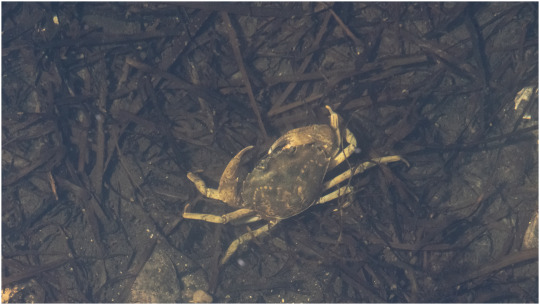
Almindelig strandkrabbe (Carcinus maenas)
Green Shore Crab (Carcinus maenas)
#Almindelig strandkrabbe#Carcinus maenas#Carcinus#Green Shore Crab#Krabbe#Crab#Portunidae#Sommer#Summer#Nibe Havn#Limfjorden
11 notes
·
View notes
Text
Strandkrabben-Bisque
In der zweiten Julihälfte verbrachte ich Teile meines Sommerurlaubs auf der schönen niederländischen Insel Texel. Einer der Höhepunkte war übrigens das Treffen mit dem charmanten Krautjunker Goswin am Paal 17.
Goswin kommentierte dieses Foto später damit, dass er darauf aussieht wie Bilbo, der gerade von Gandalf zu einem neuen Abenteuer überredet wird…
In der Hafenstadt Oudeschild amüsierte ich…
#Anders Schønnemann#Carcinus maenas#Gone Fishing: Fisch und Meeresfrüchte#Mikkel Karstad#Prestel Verlag#Rezept Strandkrabben#Strandkrabben#Strandkrabben Rezept#Strandkrabben-Bisque
1 note
·
View note
Text
Things I saw on my dive today
Anemone (no clue about the species, was brown)
Crabs, (Cancer pagurus and Carcinus maenas probably?? A few were swimming (small and orange), one was blue/black with red eyes)
Various brown/red small fish (I know basically nothing about fish so fuck knows lmao)
Sea squirts (on seaweed, clear with bluey tint)
Peacock worm (Sabella pavonina I'm pretty sure)
Sea star (Asterias rubens for sure, and larger bluey ones)
Urchins (Echinus esculentus ?)
Pipe fish (??? No idea lmao)
67 notes
·
View notes
Text

The Seashore. Written by Jennifer Cochran. Illustrated by Kenneth Lilly, Patricia Mynott, James Nicholls, and George Thompson . 1973.
Internet Archive
A.) Calanus finmarchicus
B.) Larva of the shrimp Crangon crangon
C.) Larva of the barnacle Semibalanus balanoides
D. + E.) Different stages of the growth of Carcinus maenas
F.) One of the stages of Pisidia longicornis
G.) Eurydice pulchra
H.) Larva of Clytia Johnstoni
#marine life#crustaceans#copepods#shrimp#barnacles#acorn barnacles#crabs#european green crabs#long-clawed porcelain crabs#isopods#speckled sea lice#cnidarians
357 notes
·
View notes
Text

This is incredibly cool! It's a preprint so it's still undergoing peer review, but an enormous study on the terrestrialization of crabs over several stages and phylogenetic groups was just finished and there are some super illuminating findings for how crabs have evolved over hundreds of millions of years. Some of the most interesting implications are those of how invasives, like (my eternally beloathed) Hemigrapsus sanguinus and Carcinus maenas, often have the kind of traits for high habitat adaptability/tolerance that many of these common ancestors for terrestrial crab groups may have shared.
FULL TEXT check it out, it's a really awesome read!
320 notes
·
View notes
Text
Today was the day i finally started researching for science... i think.
I had to identify each species that my advisor managed to find on a beach.
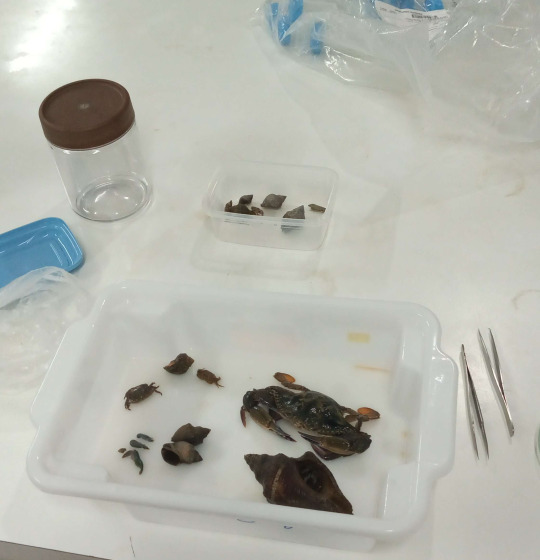
They were collected in a beach which had rocks, on low tide, so some of the species collected were actually common from reefs.
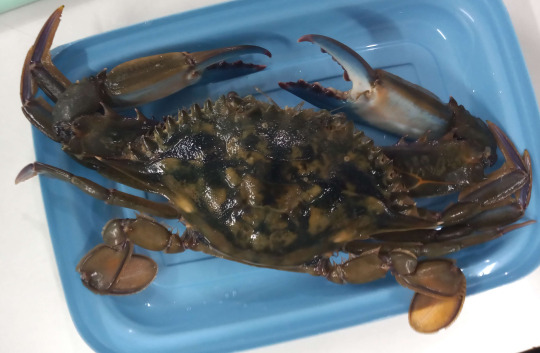
I went from the crabs first, because I thought they were the easiest ones to identify... boy i was wrong, just the brachyura identification of the coast of brazil had basically 800 pages, but this big one here was actually easier to id, because, for one, because of the slippers on their backs, they are surely what the brazilians call a "siri", so from the family Portunidae, to get the actual genre and species was a little bit tricky, basically, the males from the genre Callinectes have their telson in a T form (the book is very vague about what the hell is a T, but its their telson), you had to see little spikes they have around the eyes to determine the species, its probably a Callinectes danae
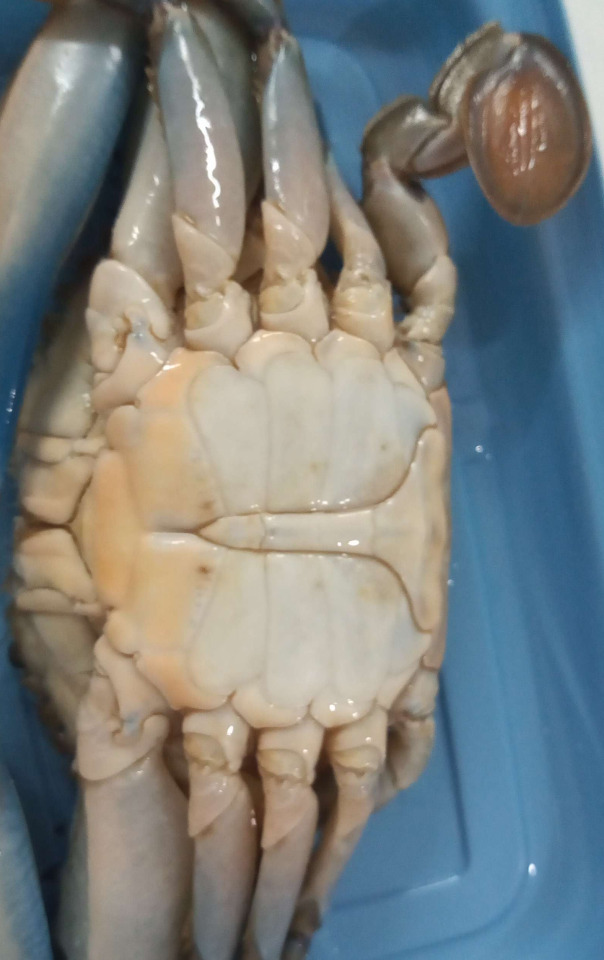
its not their penice s btw,,,
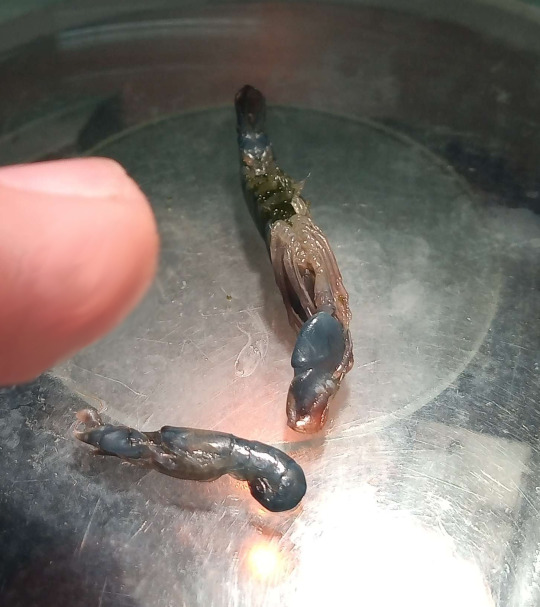
these are pistol shrimps, one of them had eggs with them, i'll have to study some Alpheidae (pistol shrimp superfamily) identifications so i can ID these ones.
The other ones were 2 Carcinus maenas and a bunch of Clibanarius crabs, that i won't show cuz they're pretty gory, because they were stuck in their shells and i had nothing to break the shells, so i had to yank them out (worst part of doing ids with crustaceans).
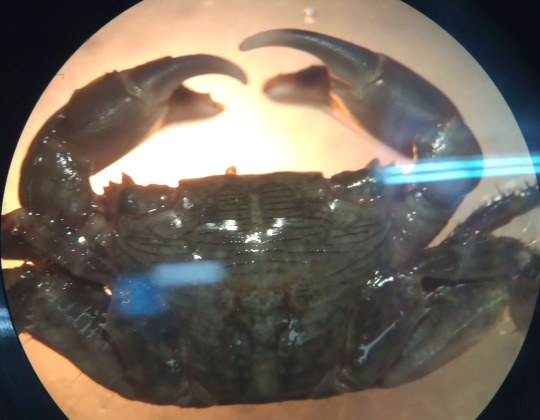
also was a pain in the ass to look cleary throught the lenses of the macroscope, so i made a sketch based on what happened

thats it....
7 notes
·
View notes
Text










18.07.24 - Young Darwin Scholarship Day 4
The bulk of today was devoted to rocky shores. We went to East Prawle where we were going to lay quadrats and collect data on the species present at the various coastal zones but as the data software wasn’t working we just explored. I couldn’t take in much information because my pain has been getting worse, I’ve been getting more and more tired and it’s been harder to think clearly, so this post will mainly just be brief descriptions of some of the things I saw and photographed.
1-2. A male European Green Crab (Carcinus maenas)
3. A lot of different seaweeds. Important information is that they are not plants and some of them, such as red seaweed, parasitise each other which is interesting. I can’t remember which species it is but one of them has bulges that look like air sacks but are in fact filled with reproductive material (I guess semen would be the closest analogue). Others do have air sacks.
4. Some sponges of which I don’t know the species - genetically and evolutionarily the closest relative of humans that can be found in a rock pool.
5. Beaded Anemone (Actinia equina)
6. Snakelocks Anemone (Anemonia viridis)
7. The ornate underside of a Cushion Star (Culcita novaeguineae)
8. Rockpool Shrimp (Palaemon elegans)
9. A Grey Seal (Halichoerus grypus) observed from a distance (getting too close stresses seals significantly). This was an interesting find. We didn’t see seals when we were purposely seeking them out on yesterday’s boat trip but we saw one today and the Grey Seal, with it’s characteristic long snout, is more rare on our coastlines than the Common Seal.
10. An out-of-focus Glow-Worm (Lampyris noctiluca), curiously not a worm but a beetle. There were several in the verges between the beach and field centre after we returned from our final evening campfire. We also detected bats on our bat detectors and saw them flying around, possibly Daubenton’s (Myotis daubentonii) as a population nests by the bridge. We also took one last chance to try and spot otters. At one point in the gloom I saw some large ripples and what appeared to be a dark shape but I don’t know if my eyes were playing tricks on me.
#personal#photos#natural history#scholarship#wildlife conservation#not so daily positives#naturalists
4 notes
·
View notes
Note
Is it possible for a green crab or “shore crab” to live in full freshwater?
Hi there, are we talking about Carcinus maenas? If so, then no. Research I did a while back suggests it can tolerate down to 1.004 long term but really is best kept around or upwards of 1.010 (about half strength sea water).
0 notes
Video
Voyage to the Bottom of the Sea (EXPLORED) by SkyeWeasel
Via Flickr:
For Macro Mondays theme 'Bottoms Up'. This shows the underside of a small shore crab, Carcinus maenas. Explored July 10, 2017.
#Macro Mondays#Bottoms Up#macro#crab#shore crab#Carcinus maenas#underside#black background#crustacean#claws#exoskeleton#carapace#arthropod#segments
4 notes
·
View notes
Photo

Beach Drama
#photography#animals#crustaceans#crab#crabs#probably a#green crab#carcinus maenas#beach#ocean#the beach#coastal#marine life#dead#death#spring#photographers on tumblr#original photography#i really liked this project from 2 years ago#i made a field guide for my local beach#nature#brown
8 notes
·
View notes
Text
Karen’s Blog, August 20 2009:
A few days ago I finally went on Cornell’s annual alumni field trip to Shoals Marine Laboratory, on an island off the coast of New Hampshire. Met a lot of nice and interesting people on the boat trip over—Hi Sue, hi Bob, Hi Louise and Stefan and Hannah, hi, Fern. We saw lots of sea birds and seals. We toured the island, watched the bird banding, visited labs, inspected some (very tidy) student dorms.
Cornell offers college-credit courses all summer; students come over for two week stays or longer. At lunch time I sat down with a bunch of students. We all started talking. The girl next to me looked at my name tag, startled, and said “Are you Karen Pryor?” Yes. She was very excited. “Your book changed my life.” Hmm. Too young for it to be Nursing Your Baby; she must mean Don’t Shoot the Dog; the new book’s only been available three weeks.
No, Lily Strassberg meant Reaching the Animal Mind, and got a jacketless and already well-used copy out of her back pack for me to sign.
Lily is 17. She has been clicker training dogs since she was ten, and now teaches public obedience classes. She read my story in Chapter 1 about training a hermit crab to ring a bell. So, for her class research project last week at the marine lab, she set out to train a crab to ring a bell. Her professor doubted it would work, but she was so excited about it, he let her try.
Lily collected some of the local hermit crabs around the island. They were very small and timid so she used the local green crab Carcinus maenas instead. (These are pointy-shelled Portunid crabs, like the blue crabs we eat on the East Coast, only of course they are green not blue.)
Lily used the same reinforcement procedure I did--feeding with forceps, using the movement of the forceps as the click. She shaped the behavior of shoving a hanging weight with a claw, an improvement over my more complicated job of pulling a string down.
Just to be safe, in spare moments across two days she trained two crabs, Crab A and Crab B, Abby and Bertha. She took good and thorough data, photographs, and video too. When she presented her project, the other students burst into applause. The professor said her study was ‘practically publishable.’ When the experiment was over, Lilly released Abby and Bertha back to the ocean in the same place where they were collected.
I was thrilled. So, apparently, were the crabs, and here’s why I think that.
For each session the crab had to be moved into a small experiment tank with a grid drawn on the floor (to measure exactly how far the crab came toward the target each time.) At first the crabs were hard to catch, and struggled mightily when lifted into the air. But soon, they got it—Oh, I’m flying to the place where I train them to feed me delicious stuff—and they just held still to be picked up by the shell, and relaxed completely in the air, legs hanging down calmly. Now I ask you: isn’t that cool? Clicker-wise ‘operant’ crabs?
What were the chances that out of 100 people or more in the room I would sit down next to Lily?
You will be hearing more about Lily, I bet.
326 notes
·
View notes
Text
Still on hiatus (senioritis is kicking my ass) but I wanted to share a bit of beach stuff


Like this pair of Atlantic horseshoe crabs (Limulus polyphemus) that I found stranded! I set them back in the water to... get back to their business.


And a female European green crab (Carcinus maenas)!

And a little American oystercatcher (Haematopus palliatus)
59 notes
·
View notes
Text


green shore crab waving hello (o^^o)
this is a classic looking crab right here. their shells are so detailed with camouflage to blend into the intricacies of the shoreline and evade the ever-vigilant gaze of seabirds >:) truly some fascinating bottom feeders right here! crabs are known for cannibalism but also for growing entire limbs back from scratch as long as the center body is in tact! and to think though convergent evolution, these things evolved 5 separate times!!!!!! we should appreciate crabs more
Carcinus maenas
45 notes
·
View notes
Text
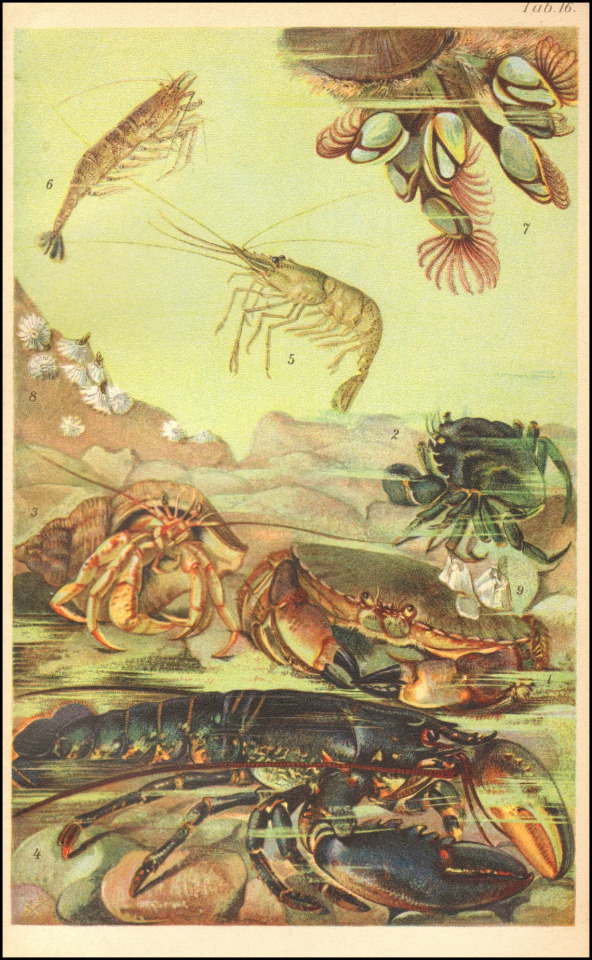
From Der Strandwanderer by Paul Kuckuck, 1905.
1.Edible Crab (Cancer pagurus), 2. Common Shore Crab (Carcinus maenas), 3. Common Hermit Crab (Pagurus Bernhardus), 4. European Lobster (Homarus vulgaris), 5. Baltic Prawn (Leander adspersus), 6. Brown Shrimp, Common Shrimp or Sand Shrimp (Crangon vulgaris), 7. Goose Barnacle (Lepas hilli), 8. Acorn Barnacle (Balanus balanoides), 9. Crenate Barnacle (Balanus crenatus).
153 notes
·
View notes
Text
The Effect of Salinity Acclimation on the Upper Thermal Tolerance Threshold of the European Green Crab
Abstract
Fluctuations in salinity and temperature, among other varying environmental conditions, are stressors in estuaries and may work together to alter the physiological response of organisms that inhabit such environments. Laboratory assessments that investigate how animals respond to multiple environmental stressors can provide an ecological framework for understanding physiological performance across varying conditions. In this study, European green crabs, Carcinus maenas, were collected from Seadrift Lagoon, California, USA (37°54′27.82″N, 122°40′19.56″W) and were lab-acclimated at three different salinity concentrations typical of many estuaries: 15, 25, and 35 PSU at 12 °C (± 1 °C). After acclimation, crabs from each salinity treatment experienced a temperature ramp of 2 °C every 30min until they reached their critical thermal maxima (CTmax). Crabs held at 15 PSU acclimation treatment died at significantly lower temperatures than those acclimated to 25 PSU, demonstrating that the upper thermal tolerance of C. maenas is decreased at lower salinities. Hence, crabs in the northeast Pacific, which are limited to estuarine and brackish waters by marine predators, may be physiologically limited from further expanding their southern range boundary due to the effect of increased temperature on physiological performance. This work took place in March, 2013 and highlights the importance of examining the effect of multiple stressors to understanding what factors may limit or enhance range shifts.
Keywords: Carcinus maenas; Multi-stressor; Salinity acclimation; Thermal tolerance; Abiotic resistance; Invasive species
Introduction
Ecophysiological research has historically focused on altering one abiotic variable at a time to measure the physiological response to that variable. However, examining how multiple stressors affect organisms provides a more holistic view into factors that govern distribution and abundance of species [1-3]. The intersection of fresh and salt water, coupled with thermal fluctuations typical of estuaries can affect physiological performance, leading to geographic distribution limitations of estuarine organisms Sokolova et al. [4]. Additionally, along the west coast of North America, the estuarine distribution of Carcinus maenas has been attributed to predation by a larger, aggressive native crab Hunt & Yamada [5].
Owing to their broad thermal and salinity tolerance, C. maenas has successfully invaded coastal habitats of four continents, including the west coast of North America [6-8]. In addition, C. maenas can survive and reproduce in a wide range of salinity concentrations because they are proficient osmoregulators [9]. Nagaraj [6] found that salinity had little to no effect on developmental rates of C. maenas; however, zoeae kept in high salinity treatments (25 and 35ppt) had the greatest survival rates at the lowest experimental temperature, ~10 °C [6]. While these studies are informative, they do not necessarily reflect the dynamic abiotic environment that C. maenas inhabits.
In the eastern Pacific, C. maenas is preyed upon by native crabs, limiting their habitat use of the open coast, consequently forcing C. maenas to occupy areas with greater temperature and salinity fluctuations [5]. As such, C. maenas populations generally reside in upper estuaries, which are characteristically warmer and less salinated [5]. For C. maenas specifically, exposure to lower salinities leads to increased oxygen demand (i.e. increased anaerobic metabolic rate) as a means to offset the concomitant increase in hemolymph pH, which in turn affects the hemolymph’s O2 affinity [10]. The variable salinity concentration of estuaries in conjunction with their often warmer conditions [5] may combine to limit the ability of C. maenas to mount robust heat stress response, thus lowering the upper thermal tolerance, despite it being a euryhaline hyperosmotic regulator. Ionic stress combined with heat stress has been investigated in larval C. maenas; however, the effect of variations in salinity concentrations on adult crab upper thermal tolerance has yet to be investigated. To better understand how variations in salinity affect the upper thermal tolerance of adult crabs, animals were acclimated to three different salinity concentrations common to estuaries and then were subject to acute heat stress. Given that C. maenas is an osmoregulator, such that decreased salinity increases metabolic demand, we hypothesized that a reduction in salinity would circumvent the ability of C. maenas to mount a robust response to heat stress, thus reducing organismal thermotolerance.
Methods
Sampling, maintenance, and salinity treatments
Male and female Carcinus maenas were collected from Seadrift Lagoon, Stinson Beach, California, USA in August 2012, and transported to Portland State University, Oregon, USA. The crabs were temperature acclimated at 12 °C (± 1 °C) and 30 PSU for approximately 210d prior to the salinity acclimation phase. Three groups were then formed via random selection and acclimated to 15, 25, or 35 PSU, encompassing the salinity conditions where they are typically found (~10-35 PSU) [11] for 56d. Each salinity-controlled treatment group was held in a separate, self-sustaining, recirculating-water, temperaturecontrolled aquarium table system in artificial sea water (Instant Ocean) treated with 20mL of a nitrogen reducer (AmQuel) per approximately 151.42L of water, when nitrogen was high. System salinity was held within ± 1 PSU of the target salinity concentration for each treatment group by thrice weekly salinity measurements and additions of deionized water as needed to maintain the respective salt concentrations. The crabs were fed a medley of squid, fish, and mussels ad libitum, once per week.
Heat ramping
Members of the C. maenas sample population (n = 15 per treatment) were randomly selected from each salinity treatment and placed in recirculating and continually aerated water bath (Lauda RM6 MGW) filled with aquarium water from their acclimation tank. The bath was then ramped up by 2 °C every 30min, beginning from a base temperature of 12 °C ± 1 °C Kelley et al. [7]. The temperature at which each crab expired was monitored with a Vernier thermometer probe (± 0.1 °C) and recorded. Critical thermal maximum (here after CTmax), a standard measure of temperature-related animal death, was determined via a set of criteria verified by physical examination [7]. If the specimen was unresponsive to manipulation and could not right itself, it was held just below the surface of the water and examined for signs of respiration, i.e., water movement via the activity of the scaphognathite Crothers [12]. If cessation of respiration lasted for longer than 30s, the specimen was considered physiologically deceased and was removed from the water bath. Upon each crab’s death, we removed the specimen and recorded its treatment group, sex, temperature at death, and carapace width. Heat ramping continued until all of the experimental animals expired.
Statistics
To determine that the assumptions of normality and homoschedasticity were not violated, the Kolmogorov-Smirnov Goodness-of-Fit Test (P = 0.57) and Bartlett’s test for equal variance (P > 0.1) were used (Graphpad Prism) prior to analysis. Analysis of Covariance (ANCOVA), followed by Tukey’s Multiple Comparison Test were employed to determine whether salinity (fixed) and crab size (continuous covariate) affected the upper thermal tolerance of the crabs (Minitab 17). To further explore the relationship between carapace width (CW) and CTmax, a linear regression was used (Graphpad Prism).
Results
The three salinity treatments differed in their mean CTmax values (Figure 1, Table 1, ANCOVA, F(2,42) = 4.16, P = 0.02). The mean differences in CTmax between 15 PSU and 25 PSU, 15 PSU and 35 PSU, and 25 PSU and 35 PSU were -2.6, -1.3, and 1.3 °C, respectively. Tukey’s Multiple Comparison Test revealed a significant difference between the 15 PSU and the 25 PSU samples: the average CTmax of the 15 PSU sample (32.5 °C ± 0.6 °C) was significantly lower than that of the 25 PSU sample (35.0 °C ± 0.46 °C, Figure 1). The 35 PSU treatment was intermediate, having an average CTmax of 33.7°C ± 0.6, and did not significantly differ from the CTmax values of the other two salinity treatments. CW also significantly affected the upper thermal tolerance threshold, with lower CTmax for larger crabs (Figure 2: r2 = 0.2, y=-0.1*x + 41; ANCOVA. F(2,41); P = 0.008).
Discussion
We found that adult crabs that were acclimated to low salinity concentrations showed greater susceptibility to rising temperature. Crabs acclimated to lower salinity had a significantly lower CTmax than crabs acclimated to 25 PSU, supporting our initial hypothesis that lower salinity environments can negatively affect the upper thermal tolerance of adult Carcinus maenas. This finding was in accordance with a study that examined the effect of salinity acclimation on thermotolerance and larval development distribution of larval C. maenas Nagaraj [6]. Similarly, in another study, temperature interacted with salinity, together affecting larval development duration and attachment of the barnacle Balanus trigonus Thiyagarajan et al. [13]. Variations in salinity and temperature significantly modified the development of Nile tilapia, Oreochromis niloticus, but the interaction of the two variables modified development in unpredictable ways, with growth rates peaking at different temperatures as salinity changed Likongwe et al. [14]. A decrease in salinity concentration was also shown to significantly limit the range of temperatures tolerable by the bivalves Mercenaria mercenaria and Crassostrea virginica, for both survival and larval development Davis and Calabrese [15].
Our CTmax data suggest that after acclimation to a low salinity (15 PSU), temperature tolerance decreased significantly, offering an additional abiotic variable that may further limit their distribution. Hence, a large expansion south to warmer waters along the western North American coast seems unlikely This observed decrease in temperature tolerance implies that although C. maenas is capable of tolerating low salinities, it is metabolically taxing for them and could synergistically alter their ability to physically cope with thermal stress. Southward expansion of east coast C. maenas populations has been documented to be limited by native crab species found in estuaries De Rivera et al. [16], our data suggest that salinity and temperature in concert with predation together limit southward expansion. Together these multiple stressors may determine the potential for future range expansion of C. maenas.
A recent study found a significant relationship between environmental temperature and body size across this population of C. maenas, with larger crabs occupying areas of cooler temperatures, a phenomenon known as the temperaturesize rule for ectotherms Kelley et al. [17]. Here, we have shown that larger crabs tend to have a lower overall thermal tolerance threshold than smaller crabs (Figure 2). This study provides further evidence supporting the temperature-size rule in that large crabs that inhabit warmer, hyposaline water are more susceptible to heat stress, such that temperature acts as a selection force against larger body size.
Our study’s findings add to the body of literature supporting the conclusion that multiple stressors combine synergistically and may affect geographic range expansion and possibly overall success; however, the exact effects and synergistic relationship differ across species Todgham et al. [18], Crain et al. [1], McBryan et al. [19], Todgham and Stillman [3]. Together these studies, and others, suggest that the interaction between salinity concentration and temperature on aquatic life is not purely additive, and that more research is needed on multiple environmental stressors acting in one system, especially to predict the geographic distribution of species as their ranges shift due to climate change or biological invasion. Because of overwhelming evidence of climate change, it is important to consider the implications of inevitable further rise in temperature and changing estuarine salinities on native and non-native marine species in the near future Kelley [20], Sorte et al. [21]. The predicted change in riverine input could alter salinity and temperature along with pH, and could be modeled to understand potential future distributions. Life at low salinity levels and high temperatures becomes increasingly difficult for native and invasive species and can cause northward range expansion of C. maenas Kelley et al. [3], Hunt and Yamada [5]. It is important to understand the many abiotic factors can affect C. maenas distribution in order to predict future range expansions and possible ecological and economic effects of a non-native species on native marine animals and delicately balanced ecosystems.
Conclusion
This study documents that other environmental factors influence the upper thermal tolerance of the invasive Carcinus maenas, the European green crab. Understanding the role that dynamic environments play in regulating the physiological tolerances of invasive organisms is critical to gaining insight regarding the ecology of biological invasions. This research underscores the importance of, and the need to conduct studies that investigate the interplay of multiple environmental stressors on the physiology of non-native species.
To Know More About Journal of Oceanography Please Click on: https://juniperpublishers.com/ofoaj/index.php
1 note
·
View note
